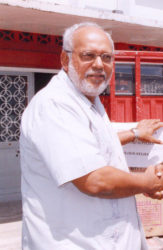Disputing reports of the deplorable state of the Skeldon Estate, former President Donald Ramotar yesterday charged that the Guyana Sugar Corporation’s (GuySuCo) reported plan to either sell or diversify it was just part of the APNU+AFC government’s plan to shut down the sugar industry.
“I find it very strange that they are speaking of Skeldon Factory as the state it is in like that because only last year they mentioned how well the factory performed and had credited that because there (was) political interference, now today it made a 180 (degree turn) and (it) is that bad?,” Ramotar questioned.

Further, he added, “Moreover the factory was meeting its potential. In 2014 we changed the punt dumper and it was lifting more than 215 tons an hour and so forth now all of a sudden after this good performance on the second crop last year we hear of this. Is the government deliberately sabotaging Skeldon to find an excuse to shut it down and close out the sugar industry here?”
Observers have noted that even though Skeldon was reputed to have had its best year last year, it produced only 39,000 tonnes compared to its original 2009 projection of 110,000+ tonnes. In addition, it produced the tonnage at a high cost relative to the rest of the industry.
Chairman of the Board of GuySuCo, Dr Clive Thomas, told Stabroek News in an interview last week that the corporation has already spoken to potential buyers and is awaiting the go-ahead from government to continue the discussions on the selling of the Skeldon Estate.

According to Dr Thomas, selling the estate is one of the options the Board has and its members have also made other proposals to Cabinet and are awaiting a decision.
Contributing in a major way to the estate’s woes is the US$110 million, Chinese-built factory, conceived by the PPP/C government to secure the future of the sugar industry, which has been a poor performer from the inception and has produced nowhere near the 110,000 tonnes of sugar that was promised each year from 2009.
A recent study done at the estate by the Wartsila Company “showed that the cost of producing the cane was something we cannot afford. At the moment, we are earning [US] 22 cents per pound and the estate is producing at [US] 37 cents per pound, Dr Thomas said.
The GuySuCo Chairman emphasized that the state of the factory and the cost of repairs are beyond what GuySuCo can afford. And based on a recent report, the condition of the estate is “deplorable and would need quite a few million US dollars to bring it up to speed.”
“What is worse,” Dr Thomas said, “is that the labour cost that they entail for producing the cane and the sugar is less than the revenue received from selling it.
“When the workers go on strike, paradoxically the company saves money because it doesn’t have to pay them.”
The new factory at Skeldon was part of the Skeldon Sugar Modernisation Project (SSMP), which also involved expanded cane cultivation, the establishment of a refinery and the co-generation of electricity for the national grid. The brainchild of former president Bharrat Jagdeo, the SSMP started in 2003, two years after his first full term as president began.
According to the report of the Commission of Inquiry (CoI) into GuySuCo, the SSMP was initially estimated to cost US$165 million. The project eventually ended up costing US$187 million with funding from the World Bank of US$56 million, Exim China Bank – US$32 million, the Caribbean Development Bank – US$24 million and GuySuCo – US$53 million.
The report noted that GuySuCo’s contribution of US$53 million was intended to come from the sale of its land around Guyana. However, this did not materialise and the sugar corporation used its own resources thereby depleting its working capital. The escalation in the cost from US$165 million to US$187 million was also funded out of GuySuCo’s own resources.
The China National Technology Import and Export Corporation (CNTIC) was contracted to build the new Skeldon factory at a cost of US$110 million, which was part of the SSMP US$187 million. CNTIC’s work was heavily criticised and the then government ignored recommendations by Booker Tate a UK-based management firm that was hired to look at the design and oversee the implementation of the SSMP, to terminate that contract.
The factory was commissioned in August 2009 amid much hype with the previous administration saying that it would increase sugar production. Jagdeo had said that the factory was designed to have the capabilities to produce sugar for US 12 cents per pound.
When the factory subsequently encountered major problems and while he has admitted that his government should take some of the blame, Jagdeo primarily blamed Booker Tate and accused it of “incompetence.”
South African firm Bosch Engineering was hired by GuySuCo in 2013 to rectify work done by CNTIC at the Skeldon factory and to undertake rehabilitation. According to the CoI report, US$7 million had to be spent on corrective work on the factory.
‘Perplexing’
But Ramotar said that when his government left office, in May 2015, Skeldon and by extension the local sugar industry, was poised to turn a profit in a few years given their plugging of much financial and other investments into the sector. As such, he says he does not see that government has a legitimate reason for selling the Skeldon estate.
“We had done a lot of work, a real lot of work on Skeldon and it demonstrated, in the second crop of 2015, that it was making the targets .These statements are all so perplexing for me because how come this year it has taken such a dramatic plunge? Some-body needs to explain in detail the regression. It seems like they are running this factory as an excuse to shut the industry down.
GuySuCo is reported to have a debt of $80b accrued over a number of years and slumping production going back to 2005. Critics have said that the PPP/C government made no hard decisions to reverse its poor fortunes and pointed out that Ramotar himself sat on the GuySuCo board from 1992 to 2011 when he became President.
Dr Thomas told Stabroek News that there is also an option for diversification. He said, “Basically what we are trying to do is to diversify to consolidate the production of sugar,” for the higher-priced local, Caricom and US markets. The next step, he noted, “Would be to go for value-added sugar and also to try to establish and convince the rest of the Caribbean that we should be the sole producer of refined sugar. In that case we would set up a refinery. Those are the primary thoughts at this time.”
Former President Ramotar noted that key among his party’s plans for the sugar industry was also diversification but all products would have been strictly from the sugar cane.
“When we left, we left it with a plan of adding value to products. There was diversification yes but not diversifying into tilapia as what is touted now. We spoke to making ethanol, having a refinery and distillery, seeing more packaging and also moving towards more co-generation of electricity,” Ramotar stressed.
“We never planned to close any of the estates because we believed that sugar cane cultivation can work for us. We had planned to expand and give more lands to involve more farmers; that is reduce the estate lands and have private farmers in the production. Sugar will not be the only revenue earner but the sugar cane is flexible so we had a plan to switch out of sugar if it was less profitable and focus on the other things I explained. If you put a refinery you can have a 220,000 tons of white sugar and with the Caricom agreement Guyana would have had most of that market,” he added.
Ramotar said that his PPP/C government never ruled out privatisation but that it would have been the “ultimate last resort” although part of its diversification plan would involve the private sector.
“Privatisation as a last resort, but I don’t think that it would have come to that. We would have had room for the private sector because we would have had a distillery, refinery and even the ethanol product so there were many areas for the private sector involvement,” he stated.
“Given the changing dynamics of the world markets, all of this was taken into consideration and the ethanol production would have also fit into our green economy, a direction that the world is already moving towards,” he added.
The APNU+AFC government has said that major announcements are expected by the end of the year on the way ahead for sugar. Cane operations at the Wales estate are to end this year and the government and GuySuCo have pledged a variety of diversification projects there.









